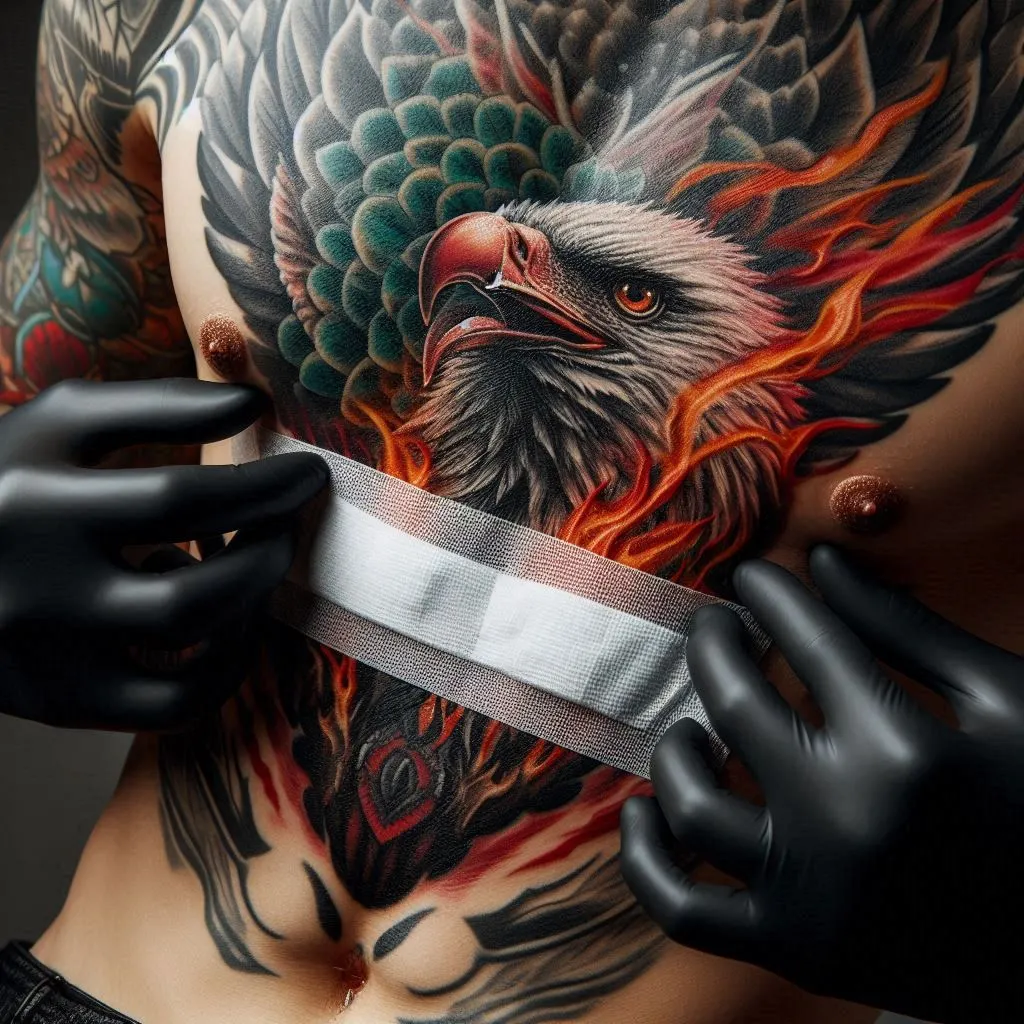Introuction: Why is Chest Tattoo Aftercare Extremely Important?
A chest tattoo is a bold statement, yet healing it is just as important as the design itself. Proper aftercare ensures your tattoo heals well, maintains its vibrancy, and prevents infections or complications. Because the chest is a high-movement area, extra care is needed during the healing process.
How to Care for Your Tattoo in the First Few Hours
What Are the First Steps After Getting a Chest Tattoo?
Once your tattoo is complete, your artist will cover it with a protective bandage. Follow these steps for proper aftercare:

- Remove the bandage after the instructed time (usually a few hours).
- Wash the tattoo gently with lukewarm water and fragrance-free antibacterial soap.
- Pat it dry with a clean, soft towel—never rub.
- Apply a thin layer of the recommended tattoo ointment or lotion.
- Avoid tight clothing that could stick to or irritate the tattoo.
Why Is It Important to Keep Your Tattoo Moisturized?
- Keeping your tattoo hydrated prevents scabbing and excessive peeling.
- Use a tattoo-safe, fragrance-free lotion to keep the skin nourished.
- Regular moisturizing will also help preserve the vibrancy of the ink.
What Not to Do in the First Few Days
During the initial healing phase, avoid these mistakes:
- No swimming, hot tubs, or soaking—water can introduce bacteria.
- Avoid direct sunlight—UV rays fade fresh ink.
- Do not scratch or pick at scabs—this can cause scarring.
- Wear loose, soft clothing—tight fabrics can irritate the tattoo.
- Limit strenuous exercise—excessive sweating can slow healing.
How Can You Prevent Infections and Complications?
What Are the Common Signs of Tattoo Infections?
While mild redness and swelling are normal, watch for these warning signs:
- Prolonged redness or worsening pain
- Excessive swelling or pus discharge
- Fever or chills
- Foul odor or extreme tenderness around the tattoo
- If you experience any of these, seek medical attention immediately.
H3: How to Protect Your Tattoo from Bacteria and Irritation
- Always wash your hands before touching your tattoo.
- Wear loose clothing to avoid rubbing.
- Change clothes and bedding regularly for hygiene.
- Avoid harsh chemicals that could delay healing.
What Are the Best Practices for Healing and Long-Term Care?
How Long Does It Take for a Chest Tattoo to Heal?
The healing process varies, but here’s a general timeline:- Days 1-3: Redness, swelling, and slight oozing.
- Days 4-14: Peeling and itching.
- Weeks 3-4: Surface healing is mostly complete.
- Months 1-6: Deep layers continue healing.
- During this time, avoid excessive sun, water exposure, and intense physical activity to prevent damage.
Do You Have to Stay Away from Sunlight and Water?
Yes! Sun and water can ruin your healing tattoo.- Sun protection: Keep it covered and apply SPF 30+ sunscreen after healing.
- Water exposure: No swimming or prolonged showers.
- Tanning: Direct sun can cause premature fading, so cover your tattoo when outside.
What Should You Do If Your Tattoo Scabs or Peels?
Scabbing and peeling are normal during healing. However:- Do not pick at scabs—this can lead to scars and ink loss.
- Apply a fragrance-free moisturizer to minimize itching.
- Avoid petroleum-based products, as they clog pores and slow healing.
How Do You Sleep with a New Chest Tattoo?
Sleeping comfortably can be tricky. Here’s how to protect your tattoo:- Sleep on your back to prevent friction.
- Use clean bedding to avoid bacterial infection.
- Wear a soft, breathable cotton shirt for added protection.
- Avoid stomach sleeping, as it can irritate the tattoo.
How Do You Keep Your Tattoo Looking Fantastic for Years to Come?
H3: What Are the Best Products to Use for Tattoo Care?
Long-term tattoo care involves moisturizing and sun protection. Use:- Shea butter or coconut oil-based tattoo-friendly moisturizers.
- Broad-spectrum sunscreen (SPF 30+) to prevent fading.
- Gentle exfoliants to remove dead skin and keep tattoos fresh.
- Tattoo balms with vitamins A and E for skin health.
How Often Do You Need Tattoo Touch-Ups?
Over time, tattoos fade due to skin regeneration and sun exposure. To maintain vibrancy:- Visit your tattoo artist for touch-ups every few years.
- Keep your tattoo moisturized and protected from the sun.
- Avoid harsh chemicals that can break down ink.
What Happens If You Ignore Aftercare?
Poor aftercare can lead to:- Discoloration and fading—lack of sunscreen accelerates ink fading.
- Scarring and infections—improper hygiene can cause permanent damage.
- Uneven healing—picking scabs or not moisturizing leads to an irregular appearance.
- To avoid these issues, follow your aftercare routine diligently.